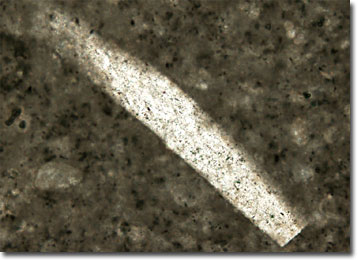Polarized Light Microscopy Digital Image Gallery
Chalk
The chalk that most people are familiar with appears in crayon form and is widely used to write on blackboards. However, many times this popular classroom tool is not made from natural chalk, but is instead comprised of an artificial substance.

In nature, chalk usually occurs in extensive deposits, many of which were formed along the bottom of the oceans millions of years ago during the Cretaceous period. In fact the name for this epoch stems from creta, the Latin word for chalk. Deposits of chalk are primarily comprised of the calcareous shells of foraminifera, which are a type of marine protozoa, but also the shells of diatoms, radiolarians, and similar organisms, as well as sponge spicules. In some areas, geological activity has shifted these massive accretions of chalk out of the sea, most notably in Dover, England where the famous white cliffs are located. Other significant chalk deposits can, however, also be found in France and the United States.
Chalk is essentially a soft, fine-grained form of limestone and, as such, is frequently utilized to generate lime, as well as fertilizer. A particularly pure form of chalk, that is one which is almost solely comprised of calcium carbonate, is often ground into a fine powder called whiting. The principal use of whiting is the manufacture of putty, but the substance is also commonly utilized in cosmetics, ceramics, paints, paper, plastics, tooth powders, and a number of other products. In addition, some unusually hard types of chalk are occasionally used as a building material.
